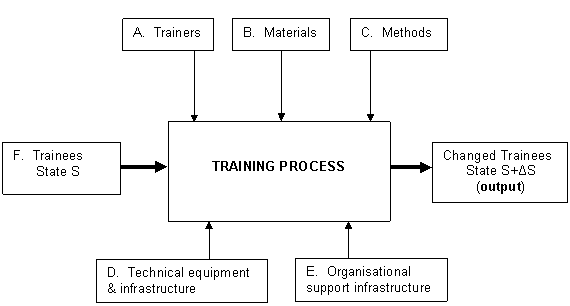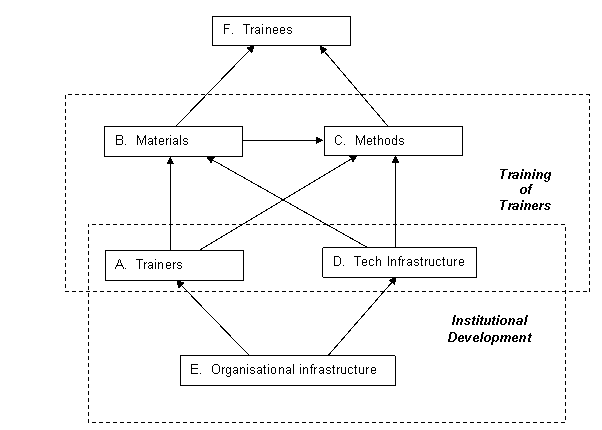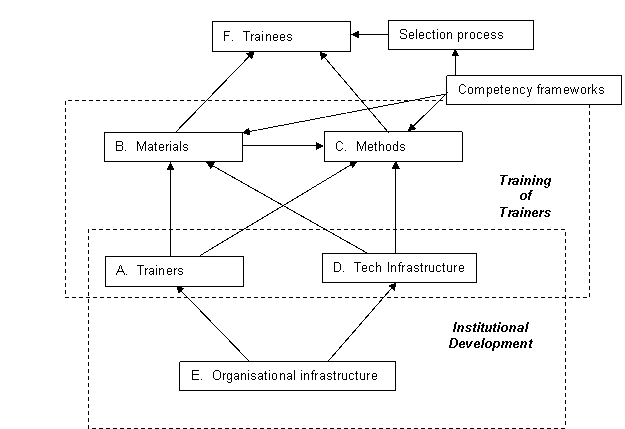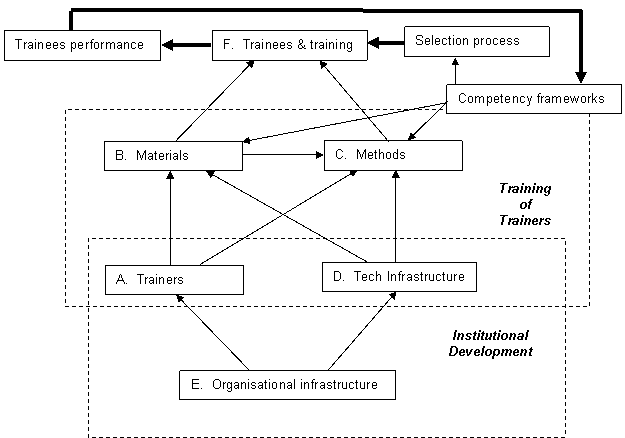 |
|
|||
Young Public Manager in Romania - a New Approach
Richard Lucking
Marius Profiroiu
Tudorel Andrei
Table of Contents
Introduction
Context
Area of Interest
The Training Process
Trainees – a competency framework
So, How Well Are We Doing?
References
Annex
Abstract
Establishing democratic and efficient public administration is the foundation of a modern democratic state. Romania is building this foundation and has made this a top priority of the Romanian Government. The goal is to achieve European standards and values of transparency, predictability, accountability, adaptability and efficiency. Romania recognizes that this is a great challenge.
Introduction
Establishing democratic and efficient public administration
is the foundation of a modern democratic state.
In 2001, the Government adopted a strategy for accelerating public administration reform. While some steps have been completed, the full objectives have not been attained. The objectives set then were too ambitious competing for financial and human resources with other priorities. Romania has adopted complex legislation promoting reform of the civil service, decentralization of fiscal resources and public services, and fighting corruption, and creating new institutions to prepare and apply the reforms. But many of these laws have not yet been fully implemented properly and new institutions are not yet fully operational. These problems have been included in several reports of the European Commission. Thus, further reforms of public administration remain as the most important objectives of the next three years during Romania’s accession to the European Union.
In agreement with the European Commission, the Romanian Government identified three areas in the area of Public Administration reform where significant progress must be made: civil service reform, decentralization and de-concentration of public services, and the policy formulation process.
According to the requirements of the European accession process, this diagnosis demands the following priorities for the reform of public administration:
- civil service reform to ensure the creation of a professional corps of civil servants, stable and politically neutral through creating a unitary and coherent legal foundation and offering professional training and human resources management with the full commitment of ministries, agencies and all other governmental institutions.
- continuing the decentralization/ deconcentration process to improve public services delivery and to create a coherent assignment of responsibilities, financial resources and rights to all levels of local governments.
- strengthen the process through which public policies are formulated by creating coordinated systems and a strengthened capacity for the management of governmental structures.
Beyond these three priorities, public administration reform will also focus on accelerating the adoption of modern information management systems throughout all levels of the public administration system as well as the streamlining of administrative procedures.
In the Civil Service low quality public services, poorly motivated civil servants, corruption, and an unfavorable public image are major weaknesses that will be addressed through achieving the following medium term objectives:
- Establish recruitment, management and training procedures for civil servants through rules and norms that can be effectively implemented;
- Reform pay scales to ensure the consistent and equitable treatment of all categories of civil servants;
- Improve the image of public administration by increasing the transparency of administrative actions and enforcing strong anti-corruption measures, visible to the public.
The following immediate objectives will begin the movement toward these objectives:
- Increase the financial and human resources allocated to the National Agency for Civil Servants and the National Institute for Administration. These resources will be included in the 2005 state budget, and the two institutions be held accountable for achieving results. Twenty new staff positions will be added to the National Agency for Civil Servants;
- Launch an international tender for a project to design a database to support the effective management of the civil service (job descriptions, educational and training qualifications, career development, salaries and performance assessments). The estimated cost of this project is 5 million Euro. The Government of Romania commits itself to co-finance this project;
- During 2004 and 2005, recruit between 600 and 1000 high-level civil servants, based on merit and professional performance, to receive attractive salaries. This management service will also be staffed from the "Young Professionals Scheme" – an EU funded project. Participants will receive a minimum monthly salary of EUR 250 during the training period and approximately EUR 500 after completing training;
- In 2004, allocate the first cohort of graduates from the National Institute of Administration based on an inter-ministerial agreement;
- Reduce the number of annual training days for each civil servant from 7 (according to the current law) to 3, reflecting available financial and training resources;
- In 2004, create an Observatory of Civil Service, consisting of representatives of the civil society, public institutions, unions and political parties, to increase the transparency of the civil service management and the independence of the service.
Context
This paper addresses issues of civil service development, in the context of public administration reform. There are, in the countries of the old and new Europes, a wide variety of approaches to training and development in the public service, and the issues raised here are based on the experience and lessons of the Young Professionals Scheme in Romania. The YPS is an EU Phare funded civil service development project, which includes a large training component, and which aims to attract some of the best Romanian graduates into the civil service. The Scheme selects, trains and assesses them, and assists their placement into the civil service within a framework of a fast-track career programme.
The broader context of this project is therefore pre-accession Romanian public administration, where there is a need for far-reaching reform, to be achieved within a short time frame. It is a context where rapid reform and the management of change are critical. It is not, as yet, a context in which steady-state evolution and gradual improvement of existing practice can be relied upon. That will come in the long-term, but the short-term need is for an approach which promotes rapid, radical and rational change in the practices of public administration.
The institutional framework for this period of fast reform is not altogether obvious. Two institutions, the National Agency for Civil Servants (NACS) and the National Institute of Administration (INA) have respective and joint responsibility, under the Ministry of Administration and Interior, for the human resources management and human resources development aspects of the civil service. However, their long-term roles and associated goals reflect a stable-state mature public administration, and an important question is whether, or how far, these can be combined with the short-term mission of change management (figure 1).
Figure 1 Change Management in the Civil Service
|
|
HUMAN RESOURCES MANAGEMENT |
HUMAN RESOURCES DEVELOPMENT |
|
SHORT-TERM Change management (close political oversight) |
Responsibility for creating a new civil service (Issues of locating and empowering rapid public administration reform) |
Responsibility for creating and developing a new civil service (Issues of training and development, and novel training needs analysis |
|
LONG-TERM Stabilisation management (general political oversight) |
Responsibility for developing the policies, standards and practices of a long-term civil service National Agency for Civil Servants |
Responsibility for training and developing the civil service in the long-term National |
At the highest level, change is likely to be stimulated by external factors (e.g. political will, arising from the requirements of accession to the EU etc); at the micro-level, through policies and programmes which introduce some form of change agent, to encourage and promote change from within (e.g. Network of Modernisers, YPs).
Area of Interest
The focus of this paper will be the shaded area of the figure: Responsibility for creating and developing a new civil service, addressing issues of training and development, and "novel" training needs analysis.
The "novel" TNA is a reminder that the new models of behaviour, attitudes, skills required in the new civil service are, on the whole not in place already. Dissemination of existing good internal practice is not enough. In all probability, models from elsewhere must be researched, evaluated, adapted and adopted.
The Training Process
Figure 2 presents a simple model of a training process, based on inputs and output.
Figure 2 Simple Model of the Training Process

The figure suggests that five types of resource are brought to bear in the training process (trainers, training materials, training methods, technical resources, and an overall organisational support infrastructure) which impact on the Trainees. They start in State S (abilities, knowledge, attitudes etc) and as a result of training change to State S + a small change (ðS).
This simple picture already raises a series of important questions, related to the changes (ðS) required, such as:
- What are the goals of the training?
- What do we want the trainees to be able to do?
- What is the relationship and relative importance of the resources?
Firstly, the relationship between the inputs and output (trainees) can be structured more carefully, to help identify interdependencies, and to reveal the domain of two common and important elements of strengthening training capacity – the training of trainers, and institutional development (figure 3).
Figure 3 The Training Process – with interdependencies

A lot of work has already been done at INA, regarding institutional capacity building and development. Adequate staffing, training equipment, development of a pool of trainers, an appropriate institutional design, have all been and will continue to be, the focus of internal reform, increased state funding, and technical assistance. Likewise, the development of trainers, through training of trainers and similar inputs, continues to be addressed. The goal of this work has been to improve the quality of the training, through the improvement of the quality and quantity of inputs, and the organisational efficiency with which it is delivered. Some of this work has been supported with YPS and other EU Phare support over the last two to three years.
But, in this paper, I want to focus on the question of outputs, and thus the issues surrounding the sixth element of the figure – the Trainees themselves. In summary, what are the changes we want, and can achieve?
Trainees – a competency framework
The starting point for the YPS, stated at the beginning of this paper, is to attract, select, train and assess some of the best Romanian graduates, for a career in the civil service. This means that the design of the selection and training process must be founded on a clear definition of the qualities we expect in a Young Professional, to ensure that we know in the context of the public service, what we mean by "the best". Broadly, our definition must encompass:
Personal qualities: qualities which are to a large degree "fixed", or at least slow to change, and so largely unaffected by the training itself.
Behavioural attributes: qualities which determine the approach and attitude to work, also slow or difficult to change, but which feature in the requirements of a new modern public administration.
Skills: qualities which training aims to change, which in some cases (e.g. foreign language proficiency) cannot be completed through a short or medium term training programme.
Knowledge: the attribute which may be altered, through study, and requiring continual updating throughout a career. It is an important component of self-study and in-service training, but not the primary focus of pre-service training
So, it is important that we distinguish those characteristics which we want in the new civil servants – but cannot change – and which must feature as part of the selection process, from those qualities which the training can legitimately and effectively address.
The Competency Framework given in Annex 1 was developed in YPS cycle 1. This provided the basis for selecting suitable psychometric tests, to assess candidates on those personal and behavioural qualities which cannot be significantly altered through the training programme. In cycle 2, it is proposed that some of these procedures will be used in the actual selection process, in order to be confident that we are training and developing – adding value to – those candidates most likely to benefit and make good senior civil servants. The more conventional selection methods – written examinations and interviews – should also seek to identify the personal qualities and potential identified in this framework. The aim is to select the best, and train those.
Other qualities and skills are susceptible to improvement over the long term through practice and training but, given the limited timeframe of the training programme, must already be evident at the selection stage to ensure a good standard of both candidate and final graduate. Examples are analytical and critical thinking, decision-making, communication and team skills, and foreign language skills. These also need to be tested at selection, since they indicate important aspects of the long-term quality of the candidate for senior civil service status.
The third group are skills we expect to deliver and enhance through the training itself, and these include the professional skills where exposure to a combination of knowledge, practice and experience will significantly enhance the candidate’s abilities. It is least necessary to test these at the start, as these are the skills we expect to strengthen through the pre-service training, or later in in-service training, courses. Examples include accounting or budgeting skills, constitutional and legal awareness, planning and evaluation methodologies.
The competency framework may be extended to define the skills and abilities of the Trainees, to be achieved by the end of the training programme. Such a framework would be more short-term, and more flexible over time, as the training needs for the civil servants – in this case Public Managers – became clearer. In the short-term, the "novel" training needs analysis has to draw on the expectations of the public administration, regarding EU accession, client/citizen orientation, effective coordination, and the new area of public policy making in the Romanian Government.
The model of training is now modified to include the importance of competency frameworks, as shown in figure 4.
Figure 4 The Training Process with Defined Competencies

So, How Well Are We Doing?
So far, this paper has looked at the issues of selection and training goals. The important factor within a project cycle management approach but not yet introduced, is the importance of feedback, to evaluate impact in terms of the original goals set.
The design of the YPS selection and training components makes a number of important assumptions. In summary, the key one is the definition of the qualities of a public manager. The training design is based on a preliminary analysis of this profile, expressed through the competency framework. This needs to be tested.
An important, but so far little developed, task of the YPS is to generate a database of the candidates pursuing the YPS programme. From this cycle onwards, the actual performance of the YPs can start to be assessed, once they have been placed and able to work for a few months. The individual data on each candidate – both training and potential (psychometric) results – will gradually allow a comparison between actual performance, and the factors on which the trainees were selected and evaluated.
We need to know which selected characteristics of a candidate, and which training inputs, appear to be the most important in determining their final performance, and their impact on the public administration system.
This feedback loop is the most neglected instrument in a lot of management practice in the public sector. It is hoped that the YPS will, through experience and actual practice, will be able to point to methods of selection, training and assessment of civil servants, which, in the context of rapid change and reform, will have shown themselves to be the most effective indicators of successful outcomes. The cost and potential impact of training make this feedback a key factor in the development of long term excellence in new training institutions.
Figure 5 The Training Process with Feedback

References
Annex
Annex 1 Summary Competency Framework for Public Managers
|
General Competency
|
Sub-Competency |
Specific Competency |
|
Delivery skills (motivation and commitment) |
Drive for results |
Planning and prioritising work activities |
|
Proactive problem solving |
||
|
Resilience |
||
|
Accountability |
||
|
Learning and self-improvement |
Learning continuously |
|
|
Adaptability |
||
|
Intellectual capacity |
Decision making |
Analytical and critical thinking |
|
Taking and implementing decisions |
||
|
Taking calculated risks |
||
|
Constructive thinking |
Thinking creatively |
|
|
Identifying innovative solutions |
||
|
Interpersonal skills
Team skills |
Building productive relationships |
Building relationships |
|
Achieving goals through relationships |
||
|
Communicating with impact |
Communicating |
|
|
Influencing, negotiating and mediating |
||
|
People management |
Ability to train others |
|
|
Team player |
Ability to contribute in a team environment |
|
|
Change Agent |
Change Agent |
Promotes change and thrives on change |
(top)
